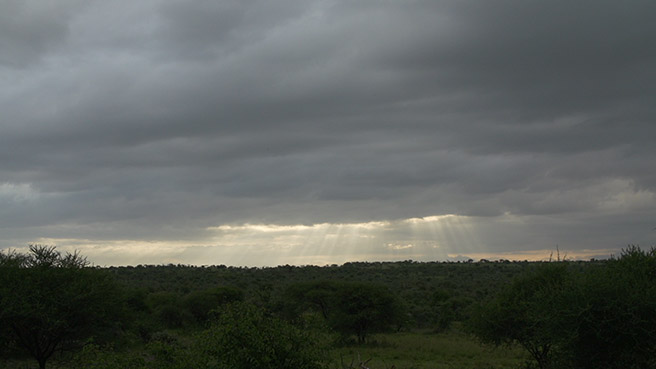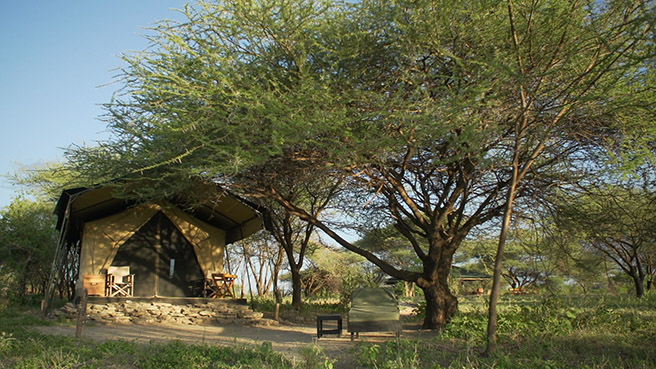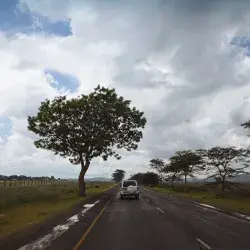WILD to INSPIRE: Glamping for Conservation in Manyara Ranch

For my third and final week in Tanzania, I had the privilege of spending time at the Manyara Ranch Conservancy. Previously owned by the Tanzanian government, the ranch was established by AWF in 2001 to address the threats of degradation and habitant fragmentation.
Nestled between Tarangire and Lake Manyara National Park, Manyara Ranch is located in a crucial migration route between the two parks. While national parks are invaluable to the preservation of wildlife, if the lands between national parks aren’t conserved, then animals are at risk of becoming isolated to the parks they inhabit. Wildlife can’t migrate between parks if the migration corridors suffer from encroachment, over-grazing, and poaching.
When the Kwakuchinja corridor that connects Tarangire to Lake Manyara National Park was at risk of being closed, AWF came in to save the corridor. AWF established the Tanzania Land Conservation Trust (TLCT), which acquired the land from the Tanzania government and formed Manyara Ranch Conservancy. Since it’s acquisition in 2001, the conservancy has successfully maintained the corridor so that animals can safely and effectively migrate. Although there are always challenges, especially with poaching, AWF and Manyara Ranch are making great strides in conservation.
I thought it was pretty fitting to spend my final week in Tanzania at the Manyara Ranch Conservancy because a bulk of the work AWF is doing in the Maasai Steppe Landscape is within the ranch. While I’ve been learning a ton about AWF’s work in the landscape, I was most impressed with all of MRC’s conservation efforts. In addition to filming a conservation school (Manyara Ranch Primary School) a few weeks ago, I had the opportunity to profile Manyara Ranch’s anti-poaching operations.
AWF hired a local NGO called Honeyguide Foundation, which trains and arms local scouts to protect the conservancy from trespassers. What I thought was most unique about MRC’s anti-poaching operations was the fact that they use tracking dogs to help locate poachers in the field. This technique has proven to be so successful that two of the four dogs that used to be a ranch were transferred to another national park to help with anti-poaching. It was an awesome sight to see man and dog joining forces to protect the wild.

I also had the luxury of staying at the Manyara Ranch Tented Camp during my time at the conservancy. Another AWF project, TLCT and AWF work with a private-sector partner called Mantis, which owns and operates 6 luxurious tents near the conservancy’s center. I’ve never seen, let alone stayed at one of these tents in my life, and let me tell you, this place puts “glamping” (glamorous camping) on a whole another level. My tent, the breathtaking views, and the cohabitation between tourism and conservation blew me away.
The tented camp is not only a means of bringing tourism opportunities to the ranch, but more importantly, plays a major role in the conservancy by working with local communities. A majority of the employees at the tented camp are the local Maasai and a percentage of the revenues the camp receives goes to AWF, which in turn helps sustain the conservancy and gets distributed to the local communities who live within the corridor.
Beyond the various conservation initiatives, what impressed me the most about Manyara Ranch, were the people who worked in the conservancy, specifically Fidelis Ole Kashi. Fidelis is the Ranch Manager at the conservancy, and I had the opportunity not only to interview Fidelis, but also learn about his work and understand all the challenges involved in preserving a vital corridor.
It takes a certain type of person to protect these lands, especially when faced with opposition from governments and outside entities. Unlike other individuals I’ve met on this trip, Fidelis takes his job seriously and truly possesses a passion and optimism that these lands will be protect despite constant conflict. I don’t think people realize that without conservancies like Manyara Ranch, national parks could not exist and wildlife would either leave completely or be diminished due to unviable land.
These corridors are beyond essential and having the privilege of profiling not only the conservation efforts, but also the people behind them is incredibly rewarding. So far, I’ve been having the time of my life in Tanzania. The people who make it their life’s mission to protect and conserve the wild lands and wildlife of Tanzania inspire me and I can’t wait to share their stories on screen.
